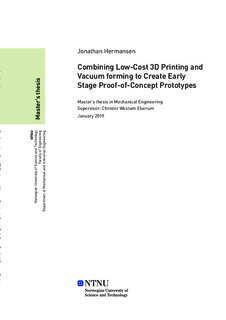| dc.contributor.advisor | Elverum, Christer W. | |
| dc.contributor.author | Hermansen, Jonathan | |
| dc.date.accessioned | 2019-10-15T14:01:21Z | |
| dc.date.available | 2019-10-15T14:01:21Z | |
| dc.date.issued | 2019 | |
| dc.identifier.uri | http://hdl.handle.net/11250/2622353 | |
| dc.description.abstract | Denne masteroppgaven ser på mulighetene for å utvide bruksområdet til 3D printing ved å lage en billig prosess for prototyping ved hjelp av 3D print og vakuumformede hybrider. Dette innebærer innkapsling av 3D-printede deler i vakumformede polymerark. Behovet for ytterligere operasjoner etter vakuumforming blir derfor eliminert. En prosess ble utviklet og viktige faktorer i prosessen ble identifisert, testet og sammenlignet. Disse testene inkluderer kvalitativ og kvantitativ testing og resulterte i et sett retningslinjer som vil promotere anvendelse av prosessen i prototypings-, produksjons- og utviklingsprosesser. Hovedresultatene viser at prosessen fungerer, selv om visse begrensninger er tilstedeværende. Koblingen mellom den 3D-printede og vakuumformede delen er i stand til å motstå krefter som er høyere enn det den 3D-printede delen tåler. Dette er imidlertid svært avhengig av testoppsettet. Mer bruksrelaterte tester, med fokus på å teste koblingen, viser at de er i stand til å motstå omtrent 470 N. Det skal nevnes at dette også er svært avhengig av brukstilfellet. En annen viktig faktor er den begrensede vinkelorienteringen som er mulig. Dette betyr at koblingene er begrenset til et område på 30° til 90° i forhold til det horisontale planet. Dette kan begrense bruken av denne prosessen. Mulig bruk av prosessen inkluderer festepunkter og strukturelle funksjoner som ribber. Hovedfokuset i denne oppgaven er på festepunkter og bare en test ble utført på strukturelle funksjoner. Testene viste likevel gode resultater. | |
| dc.description.abstract | This master thesis looks at expanding the possibilities of 3D printing by creating a low cost prototyping process using 3D print and vacuum forming hybrids. This means encapsulating 3D printed parts in polymer sheets by vacuum forming, essentially making attachments without any need for additional attachment methods other than vacuum forming. A process was developed and important factors of the process were identified, tested and compared. These tests include qualitative and quantitative testing and resulted in a set of guidelines that can be used for easier application to prototypes, products and further development of the process. The main results show that the process works, although certain limitations are present. The attachment between the 3D printed and vacuum formed part are capable of withstanding forces higher than what the 3D print itself can withstand. This is however highly dependant on the test setup. More actual usage related tests, focusing on testing the attachments, show that they are capable of withstanding up to around 470 N. It should be noted that this is also highly dependant on the use case. Another important factor is the limited angular orientation possible. This means that the attachments are limited to a suggested range of 30° to 90° relative to the horizontal plain. This might limit the use of this process. Possible use of the process include attachment points and structural attachment like ribs. The main focus in this thesis is on attachment points and only one test was done on structural attachments, however with good results. | |
| dc.language | eng | |
| dc.publisher | NTNU | |
| dc.title | Combining Low-Cost 3D Printing and Vacuum forming to Create Early Stage Proof-of-Concept Prototypes | |
| dc.type | Master thesis | |
